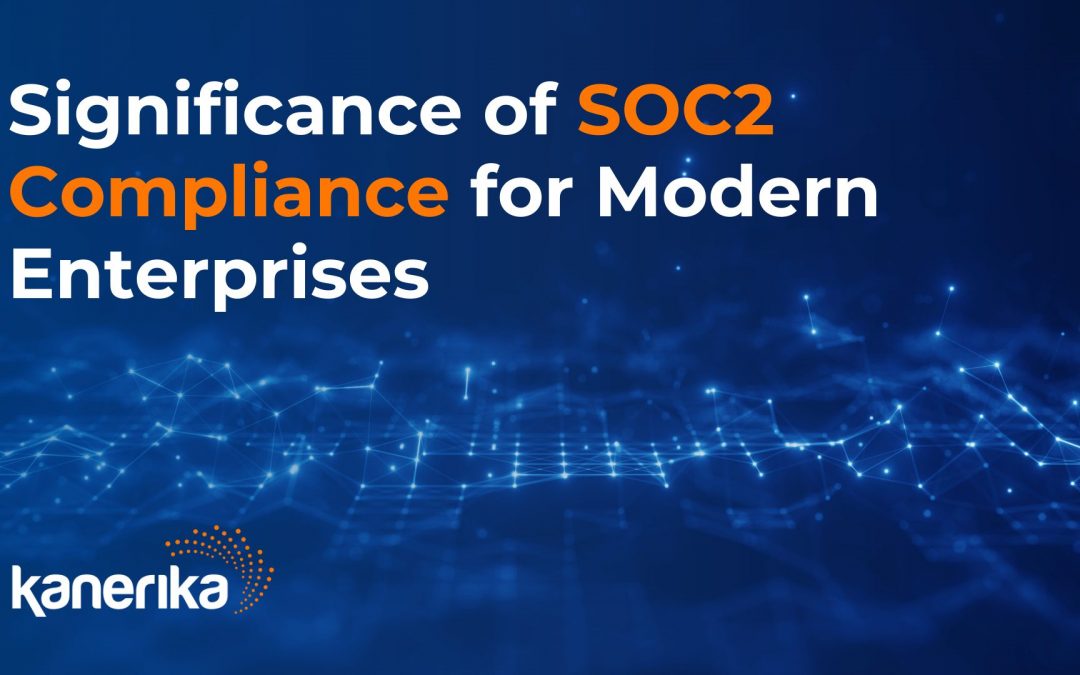SOC 2 compliance, which stands for Service Organization Control 2, is a criteria developed by the American Institute of Certified Public Accountants (AICPA). It is designed to assess and validate a service organization’s internal controls relevant to security, availability, processing integrity, confidentiality, and privacy. By adhering to SOC 2 standards, recipients demonstrate their commitment to maintaining a robust control environment and protecting customer data from potential security threats.
SOC 2 certification is crucial, especially when data protection is a universal issue, including those contracting critical services (e.g., SaaS, cloud-computing providers). This is understandable given the risk of cyber assaults like data theft, extortion, and malware installation to businesses. This occurs due to improper data handling, especially with application and network security providers.
SOC 2 Overview
Definition
SOC 2 stands for Service Organization Control 2. It is a set of criteria and reporting standards developed by the American Institute of Certified Public Accountants (AICPA) that evaluates the effectiveness of controls within service organizations. These controls are relevant to five Trust Services Criteria:
- Security
- Availability
- Processing Integrity
- Confidentiality
- Privacy
Purpose of SOC 2
The primary purpose of SOC 2 compliance is to assure customers and stakeholders that a service organization is securely managing its data. By undergoing a SOC 2 audit, the applicant organization demonstrates that they have established a robust control environment that addresses operational risks and supports reliable service delivery.
Benefits of SOC 2
Achieving SOC 2 compliance offers several benefits for an organization:
- Trust and Credibility: It assures customers and stakeholders that the organization is dedicated to safeguarding their data and maintaining a secure operating environment
- Competitive Advantage: Many organizations now require their vendors to be SOC 2 compliant, making it a vital differentiator in the market
- Improved Internal Controls: The certification audit process can identify potential control weaknesses, allowing you to address them proactively
- Reduced Risk: Demonstrating SOC 2 compliance reduces the risk of data breaches, fines, and reputational damage
Types of SOC 2 Reports
There are two types of SOC 2 reports:
- Type 1: This report assesses an organization’s controls at a specific point in time. It covers the design and implementation of the controls but does not evaluate their operating effectiveness
- Type 2: This report assesses an organization’s controls over a predefined period, typically six to 12 months. It provides a more comprehensive evaluation of the controls, including testing operating effectiveness
Also Read- ISO 27701 Certification Explained: Key Things You Need to Know
SOC 2 Compliance Criteria
SOC 2 Compliance involves meeting the requirements of Trust Services Criteria established by the AICPA. These criteria ensure that the company’s system is designed and operated to protect thier customers’ interests and maintain the security of their data.
Below are the five key Trust Services Criteria required for SOC 2 Compliance:
1. Security
The Security criterion focuses on protecting organizational information and systems from unauthorized access. This includes logical and physical access controls like firewalls, multi-factor authentication, and intrusion detection systems. To demonstrate compliance with this criterion, the organization must:
- Develop, implement, and maintain a written information security policy
- Establish access controls for each system and data, including segregation of duties
- Implement monitoring and response processes for potential security incidents
2. Availability
The Availability criterion ensures that the organization’s systems are always available for operation and use. To meet this requirement, they should:
- Establish and enforce service level agreements (SLAs) with both internal and external parties
- Develop, implement, and maintain disaster recovery plans
- Regularly monitor and report on system performance and availability metrics
3. Processing Integrity
Processing Integrity refers to an organization’s processing system’s accuracy, completeness, and validity. To demonstrate compliance with this criterion, an organization should:
- Develop and implement system input and output controls that ensure data accuracy
- Document and maintain system processing procedures
- Regularly monitor and review system processing to ensure that it remains accurate and complete
4. Confidentiality
The Confidentiality criterion requires the organization to protect sensitive information from unauthorized access. To meet this requirement, they should:
- Identify and classify sensitive information that needs to be protected
- Establish access controls and data encryption policies for sensitive data
- Regularly monitor and review access to sensitive information
5. Privacy
Lastly, the Privacy criterion demands that the organization protects the privacy of customers’ personal information. To demonstrate compliance, they should:
- Develop and implement a privacy policy that outlines how customer data is collected, used, and protected
- Establish processes to respond to customers’ requests for access, deletion, or correction of their personal information
- Regularly monitor and review compliance with the privacy policy and related regulations
The SOC 2 Audit Process
1. Pre-Audit Assessment
Before initiating the SOC 2 audit, you must conduct a pre-audit assessment. This process includes evaluating your organization’s current compliance level and identifying gaps. Start by documenting your organization’s policies and procedures and ascertain whether your existing controls align with the selected Trust Services Criteria. Next, perform a risk assessment to identify any vulnerabilities in your processes. You can then prioritize the actions needed to address these gaps and develop a remediation plan to achieve SOC 2 compliance.
2. Selection of a Trust Service Category
As part of the SOC 2 audit process, you must select the appropriate Trust Service Category that applies to your organization. Identify the category or categories most relevant to your organization, keeping in mind that focusing on more than one may increase the audit’s complexity. Each category has distinct control objectives and requirements that must be met to achieve compliance.
3. Evidence Collection
The success of your SOC 2 audit depends on the quality and appropriateness of your supporting evidence. Begin by identifying the controls you have in place for each selected Trust Service Category. Gather and organize evidence, such as:
- Policies and procedures
- Process flow diagrams
- Network diagrams
- System configurations
- Incident response plans
- Access control lists
This phase is critical, as thorough documentation will enable the auditor to understand your organization’s processes and controls deeply.
4. Audit Execution
During the audit execution, the auditor will examine and assess your organization’s control environment. This includes:
- Evaluating the design and effectiveness of controls
- Assessing the completeness and accuracy of your previously collected evidence
- Performing tests and sampling procedures to validate control objectives
You must maintain open communication with your auditor, providing any requested information and facilitating their understanding of your organization’s controls.
5. Report Generation
After the audit, the auditor will compile their findings into a comprehensive SOC 2 report. This report documents the controls in place, the effectiveness of these controls, and any instances where control objectives were not met. Additionally, the report may contain a management response to address any identified issues.
As a final step, review the report thoroughly and use the findings to improve your organization’s control environment further. Remember that maintaining SOC 2 compliance is an ongoing process requiring consistent monitoring and adjustment of your controls.
Implementing SOC 2 Controls
1. Policy Development
To achieve SOC 2 compliance, develop comprehensive policies and procedures that address the five Trust Services Criteria (TSC). Craft your policies clearly and concisely, ensuring they align with your organization’s goals. For example:
- Security: Outline measures for protecting access to your systems and data, like strong password policies and multi-factor authentication.
- Availability: Describe the steps you will take to maintain system uptime, such as redundancy planning, backup procedures, and scheduled maintenance.
2. Risk Management
Proactive risk management is essential for SOC 2 compliance. Conduct regular risk assessments to identify and mitigate risks in your systems and processes. Implement the following strategies:
- Perform an inventory of your IT assets
- Categorize risks (e.g., technology, operational, financial)
- Assess the likelihood and potential impact of each risk
- Develop risk mitigation strategies and response plans
- Monitor and review your environment for changes in risks
3. Employee Training
Empower your employees to uphold SOC 2 compliance by providing thorough training on your company’s policies and procedures. Incorporate various training methods, such as:
- Interactive e-learning modules
- In-person workshops and seminars
- Regular email updates with tips and reminders
Be sure to track employee completion of training and offer refreshers as needed to ensure ongoing understanding and adherence to your company’s policies and controls.
4. Incident Response Planning
Develop a robust incident response plan to address security incidents and data breaches effectively. Your plan should include:
- Proper incident classification and prioritization
- Clear communication protocols for internal and external stakeholders
- Defined roles and responsibilities for the incident response team
- Guidelines for evidence collection, analysis, and remediation
- Post-incident review processes to improve future responses and prevention measures
Maintaining Ongoing Compliance
1. Monitoring Controls
To maintain ongoing SOC 2 compliance, it’s essential to monitor controls regularly. Stay vigilant by setting up internal and external audits to evaluate the control environment’s effectiveness. This ensures that the controls in place are still adequate and helps identify any improvement areas. Regular monitoring of controls also includes checking security events and incident management protocols to ensure timely response.
2. Security Software
Keep all your security software up-to-date by installing patches and updates frequently. This includes firewalls, antivirus, and intrusion detection systems. Regularly evaluate the effectiveness of your security tools, and make sure to replace or upgrade them as needed. Protect your users and data with:
- Antivirus protection
- Firewalls
- Intrusion Detection Systems
- Data Encryption Tools
3. Handling Audit Trails
Timely review of audit trails is crucial in maintaining compliance. Audit trails should be analyzed to detect security threats, vulnerabilities, and unauthorized access. Maintain a systematic process for reviewing logs regularly and ensure that vital records are retained for an appropriate period.
- Perform regular log analysis
- Retain essential records for a specified period
- Stay vigilant against potential threats
4. Reviewing Access Controls
Access control is a critical component in SOC 2 compliance. Regularly review user access and accounts to ensure they have the appropriate permissions related to their job roles. Update access controls when necessary to minimize the risk of unauthorized access or data breaches.
- Perform periodic access control reviews
- Remove/disabling inactive accounts
- Update permissions in response to changes in job roles
5. Updating Documentation Regularly
For SOC 2 compliance, maintain detailed and up-to-date documentation of security policies, procedures, methodologies, and controls. Update documentation to reflect any changes in the system, control environment, or organizational structure.
SOC 2 Compliance Checklist for Evaluating Vendors
General Requirements
- Confirm the services and systems covered under the SOC 2 report
- Determine if the report is Type I (a point-in-time assessment) or Type II (covering a period of time)
Security
- Verify the implementation of multi-factor authentication and role-based access controls
- Ensure data encryption is used for data at rest and in transit
- Confirm the use of firewalls, intrusion detection, and prevention systems
- Check for regular updates and patches to systems and software
- Review the provider’s incident response plan and process for handling breaches
Availability
- Confirm the existence and regular testing of disaster recovery and business continuity plans
- Ensure redundancy and failover mechanisms are in place to minimize downtime
- Verify that system performance and uptime are continuously monitored
- Check for a schedule of regular maintenance and updates
Processing Integrity
- Ensure mechanisms are in place for data validation and error detection
- Confirm the presence of comprehensive logging and tracking of data changes
- Check for controls ensuring that data processing is authorized and accurate
- Verify that regular internal audits are conducted to assess processing integrity
Confidentiality
- Review the provider’s data classification and handling policies
- Ensure that access to sensitive data is restricted based on need-to-know principles
- Check if employees are regularly trained on confidentiality policies
- Verify that third-party agreements include confidentiality requirements
Privacy
- Review the provider’s privacy policies to ensure they align with applicable regulations
- Confirm that the provider has mechanisms for obtaining consent for data collection
- Ensure individuals have the ability to access and correct their personal data
- Check the provider’s process for securely disposing of personal data when no longer needed
Documentation and Review
- Verify that all relevant policies and procedures are well-documented and accessible
- Ensure that policies and procedures are regularly reviewed and updated as needed
- Review the latest SOC 2 audit report for any findings or areas of concern
- Look for the provider’s response to any findings in the audit report and their remediation actions
Communication and Support
- Confirm clear points of contact for security and compliance issues
- Check the availability of support for addressing compliance-related concerns
- Ensure there is a clear process for reporting and addressing security incidents
Certification and Renewal
- Verify the current SOC 2 certification status and expiration date
- Confirm the provider’s commitment to maintaining ongoing compliance with SOC 2 standards
This checklist will help you evaluate vendors on their SOC 2 compliance, ensuring they meet the necessary requirements to protect your data and maintain operational integrity.
Importance of SOC 2 Compliant Business Partner
Choosing a SOC 2-compliant business partner is crucial for your company’s data security and reputation. By partnering with a company that adheres to SOC 2 standards, you ensure your sensitive data will be managed, stored, and processed safely and effectively.
Another significant benefit of working with a SOC 2-compliant partner is the reduced risk of data breaches and security incidents. This is due to the strict controls these organizations implement to protect and manage data carefully. As a result, your company can focus on delivering excellent services to your customers while having confidence in the security of your data.
Collaborating with a reputed service provider like Kanerika can strengthen your organization’s security landscape and build trust with your clients and partners. Kanerika is SOC 2, ISO 27701, and ISO 27001 compliant. With our guidance and support, you can confidently navigate the complex world of data protection and maintain a robust security posture that protects your business and customers.
Partner with the USA’s Leading SOC 2 and ISO 27701 Compliant Service Provider. Contact Kanerika.
FAQs
What are the five Trust Service Criteria of SOC 2?
- Security: Ensures systems are protected against unauthorized access and potential security threats.
- Availability: Confirms that systems are operational and accessible as needed by users.
- Processing Integrity: Guarantees that the data processed and delivered by systems is accurate, complete, and timely.
- Confidentiality: Ensures that sensitive data is protected and accessed only by authorized individuals.
- Privacy: Applies to the appropriate use, collection, storage, and disclosure of personally identifiable information (PII).
What is the difference between SOC 2 Type 1 and SOC 2 Type 2?
How does SOC 2 compliance contrast with ISO 27001 certification?
What entities are required to undergo SOC 2 audits?
What steps are involved in obtaining SOC 2 certification?
- Identify the relevant Trust Service Criteria to be included in your SOC 2 audit.
- Conduct a risk assessment to identify potential threats and vulnerabilities.
- Design and implement security controls that address the identified risks.
- Internal testing and review of the controls to ensure they are properly designed and effective.
- Engage an independent auditor to perform the SOC 2 audit and assess your organization's controls.
- Remediate any identified deficiencies and obtain the final SOC 2 report from the auditor.


















